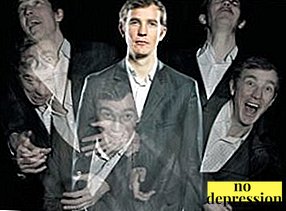Adolescence is one of the most difficult periods of life.
In the moment hormonal adjustment many diseases, including mental disorders, are exacerbated and manifest.
Fortunately, the psyche of a child at this age is still quite mobile, so most diseases are amenable to adjustment.
Types of pathology

Psychological disorder is not in the full sense mental illness.
It differs from the latter in that it is usually not accompanied by somatic diseases and is easier to treat.
In psychiatry, there are a number of deviations characteristic of specifically for puberty. According to the etiological factor mental disorders are divided into exogenous and endogenous.
The appearance of the first to blame external circumstances: drugs, alcohol, injuries, serious diseases. The latter are the result of congenital pathologies: chromosomal mutations, genetic diseases.
If the close relatives of the child suffer from mental illness, then the probability of inheritance is 25%.
In adolescence The following types of mental disorders occur:
- hypochondria;
- dysmorfomania;
- anorexia is nervous;
- derealization;
- depersonalization;
- behavioral disorders: deviant behavior, socialized behavior disorder;
- neurosis;
- schizophrenia.
- Hypochondria expressed in the conviction that a teenager has a serious illness. In this case, the child physically feels the symptoms of the disease, trying to convince others. He is so absorbed in an imaginary illness that he stops communicating with friends, goes to school. All the time he devotes to "treatment."
- Dysmorphophobia (mania) is a deviation expressed in the pathological fear of being imperfect. The child considers himself inferior externally and internally. He is convinced of his ugliness, which leads to a lack of friends and success.
- Anorexia refers to eating disorders. Girls usually suffer. They, in pursuit of harmony, refuse to eat, exhaust themselves with diets. At the same time, even reaching exhaustion, they are convinced that they have excess weight.
Sometimes anorexia is replaced by bulimia, when a person begins to absorb a huge amount of food and does not feel full.
- Derealization - a condition in which a teenager perceives the world around us as unreal, illusory. The patient sees distorted pictures, taste and auditory sensations change.
- Depersonalization - mental disorder characterized by the "loss" of one's own "me". The child imagines himself a fictional character. He begins to invent his own scientific theories concerning the meaning of life. They capture him so much that he stops going to school and chatting with friends. Misunderstanding of others causes an attack of aggression in a child.
- Deviant behavior - This is a type of behavioral disorder characteristic of puberty. The teenager ignores the social rules, wants to belong to a certain informal group, denies all the norms. Such children are prone to suicide. An extreme manifestation of deviant behavior is heboid behavior. It usually appears on the background of schizophrenia. Distinctive features are: sadism, sexual perversion, aggression, social isolation.
- Socialized conduct disorder It is expressed in the combination of friendliness and aggression in one child. With some people, a teenager maintains a normal relationship, hatred and aggression are usually directed towards teachers or parents. The disorder is manifested in deceit, theft, school absenteeism. At the same time, the child does not communicate with a bad company and outwardly looks like a completely “exemplary” schoolboy.
- Neurosis adolescent refers to a reversible disease, characterized by frequent mood swings, depression, fears. This deviation is difficult to diagnose, as many parents do not go to the doctors, writing off the child’s behavior at a “difficult age”. There are obsessive-compulsive neuroses, hysterical, depressive, asthenic, hypochondriacal.
- Schizophrenia. This disease was diagnosed in 2% of the population. The debut of the disease occurs in puberty. Conceptional schizophrenia is difficult to distinguish from the adolescent crisis. The main symptoms of pathology are characteristic of almost all adolescents: isolation, silence, sad moods, unwillingness to communicate.
If these manifestations are complemented by delusions, hallucinations, strange behavior, then it is about schizophrenia.


Symptoms and signs

All teens from time to time behave strangely.
They protest, strive for self-expression is not always the usual ways, sad, show aggression.
This behavior is considered normal and does not require adjustment.
The following symptoms should alert parents:
- Prolonged melancholy (more than 3-4 weeks).
- Uncontrolled cruelty, dangerous to others.
- Attempts to suicide, self-harm.
- Sudden attacks of fear, panic, accompanied by respiratory and heart rhythm disturbances.
- Long refusal to eat.
- Disorder, indifference to his appearance.
- Poor concentration, deterioration of memory, perception.
- The inability to adapt to the team.
- Constant change of behavior from pathological gaiety to bouts of melancholia.
- Refusal to communicate not only with parents, but also with friends.
- Prolonged hysterical seizures.
- Feelings of pain and other symptoms of diseases, which in fact the child does not have.
Possible consequences

Mental disorders in adolescents can not be ignored.
In the absence of adequate therapy, they will grow into full-fledged mental illnesses that cannot be cured.
This will make the child disabled or lead to suicide.
TO possible consequences of mental disorders relate:
- severe schizophrenia;
- suicide;
- impaired mental function;
- development of epilepsy.
Diagnostics
Proper diagnosis is a long and complicated process. Important differentiate mental disorders from serious diseases of the psyche, to establish the cause and stage of pathology.
The first step is a conversation with parents, teenagers. Psychiatrists have special tests with which they draw initial conclusions.
It is very important to study the family history, find out whether there are those with mental disabilities among close relatives.
To exclude or confirm organic brain damage prescribed encephalography, MRI of the brain, x-rays.
Treatment

For the treatment of mental disorders apply drug exposure methods and psychotherapy.
Tactics of treatment depends on the severity of the disease. In some cases (anorexia, bulimia) requires placement in a hospital, otherwise the child may die.
Mental disorders are treated in several stages:
- relief of seizures;
- stabilization;
- adaptation;
- prophylaxis
Psychotherapy held both individually and in groups. It includes the following methods:
- conversation;
- autotraining;
- the use of hypnosis;
- suggestion method.
If psychotherapeutic methods are not enough, then prescribe drug therapy.
Psychotropic drugs are used in small doses and for a short time so as not to provoke addiction syndrome.
The choice of medication depends on the type of disorder:
- Sedatives means prescribed for increased aggression, insomnia.
- Neuroleptics help in cases of acute psychosis. They reduce mental irritability, reduce aggression, suppress emotional tension.
- Tranquilizers Stop anxiety, anxiety, emotional tension. The effect is achieved through the sedative properties of the tool, while the perception of the surrounding reality does not change.
- Antidepressants help to cope with depression. Medications reduce apathy, lethargy, improve mood, normalize sleep, appetite.
- Mood stabilizers put in order the manifestation of emotions. Assign with depersonalization and other bipolar disorders.
- Nootropics improve cerebral circulation, normalize the cognitive sphere.

Also as aids apply herbs decoctions: mint, lemon balm, chamomile, valerian. Effective tincture of eleutherococcus, ginseng.
All drugs have a number of side effects, due to which they can not be used for a long time:
- drowsiness;
- fatigue;
- pressure reduction;
- muscle weakness;
- nausea;
- dry mouth;
- decreased appetite;
- headaches.
Additionally prescribed physiotherapeutic methods: magnetic therapy, laser therapy. A large role in the treatment is played by the parents of the child.
It is important that they support the adolescent, prevent stressful situations, help cope with the disease. The patient needs understanding, not criticism and condemnation.
The stabilization phase involves fixing the results, eliminating the residual effects of the disease. When adapting psychotropic drugs gradually canceled.
Prevention

Prevention of mental disorders is divided into primary and secondary.
Primary is to prevent the occurrence of the disease.
Secondary - this is the consolidation of the treatment result and prevention of relapse.
To prevent the occurrence of the disease is sometimes impossible, given the hereditary nature of many diseases. But, significantly reduce risks The following measures will help:
- Healthy lifestyle.
- Rejection of bad habits.
- Sports activities.
- Active social life of a teenager.
- Hobbies, chatting with friends.
- Parental support.
- Avoiding stressful situations and head injuries.
Secondary prevention is to prevent the recurrence of the disease. Unfortunately, in some disorders this period should last a lifetime.
Parents should closely monitor the child's behavior in order to notice deterioration in time. Secondary prevention measures:
- Compliance with the regime of work and rest.
- Avoiding stress.
- Sports or hobbies.
- Normalization of power.
- Reception of vitamins.
- Full sleep.
- Timely treatment of viral diseases.
- Regular check-ups with a psychiatrist, especially adolescents with burdened heredity.
- Passing spa treatment.
Forecast

Most mental disorders successfully treated.
To do this, it is important to diagnose the disease in time and prescribe adequate therapy.
The problem is that teenagers and parents are afraid to admit having a disease and do not turn to specialists.
Schizophrenia has a less favorable prognosis. Many patients receive a disability group.
If the patient cannot independently serve himself, then he assign 1 group. While maintaining the ability to work teenager gets 2 or 3 group, depending on the duration of the remission stage.
Teen mental disorders are easier to prevent. Parents should teach the child to cope with difficulties, not to take failures to heart, to trust parents and talk about their problems.
Bipolar disorder is a mortal danger for a teenager:



